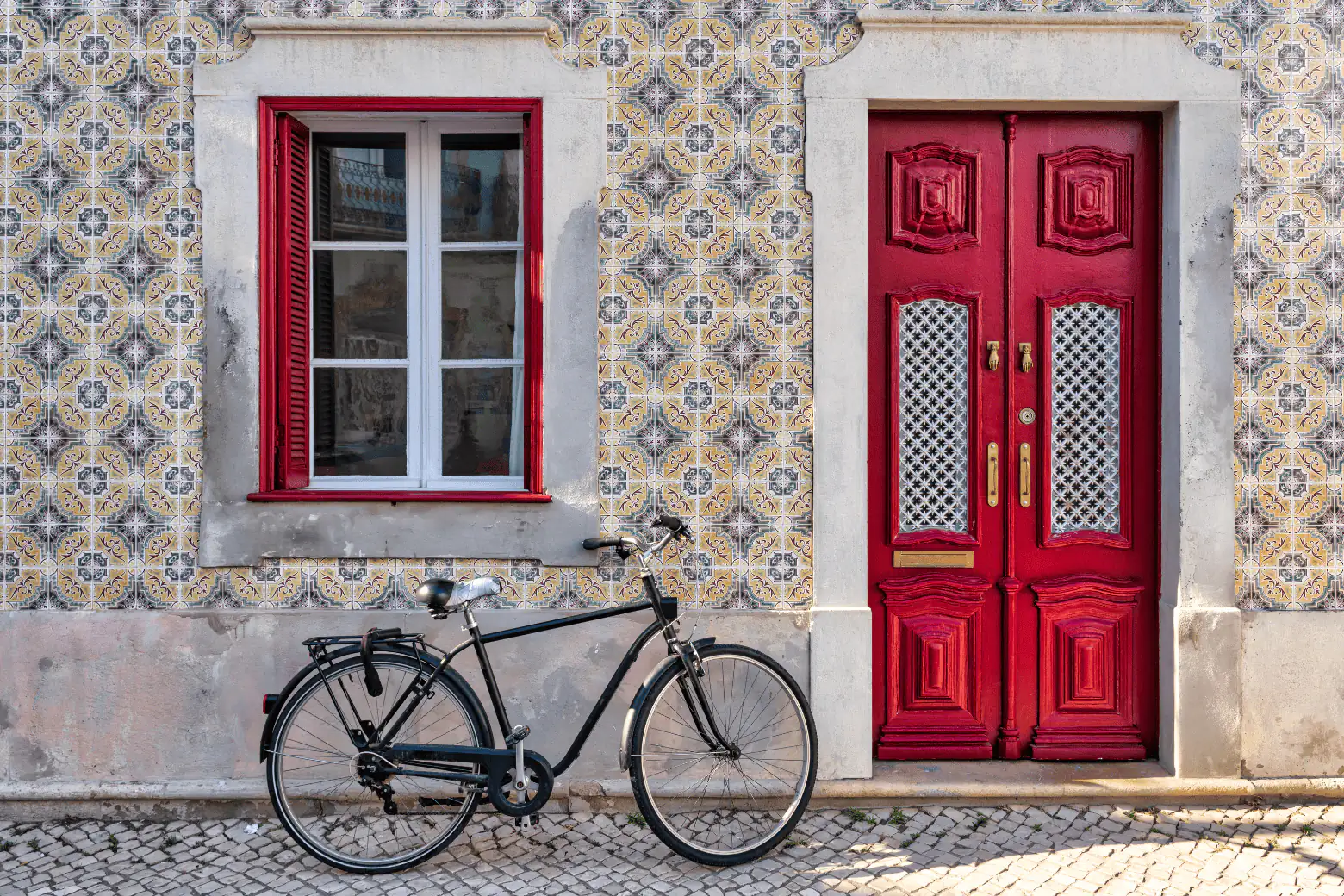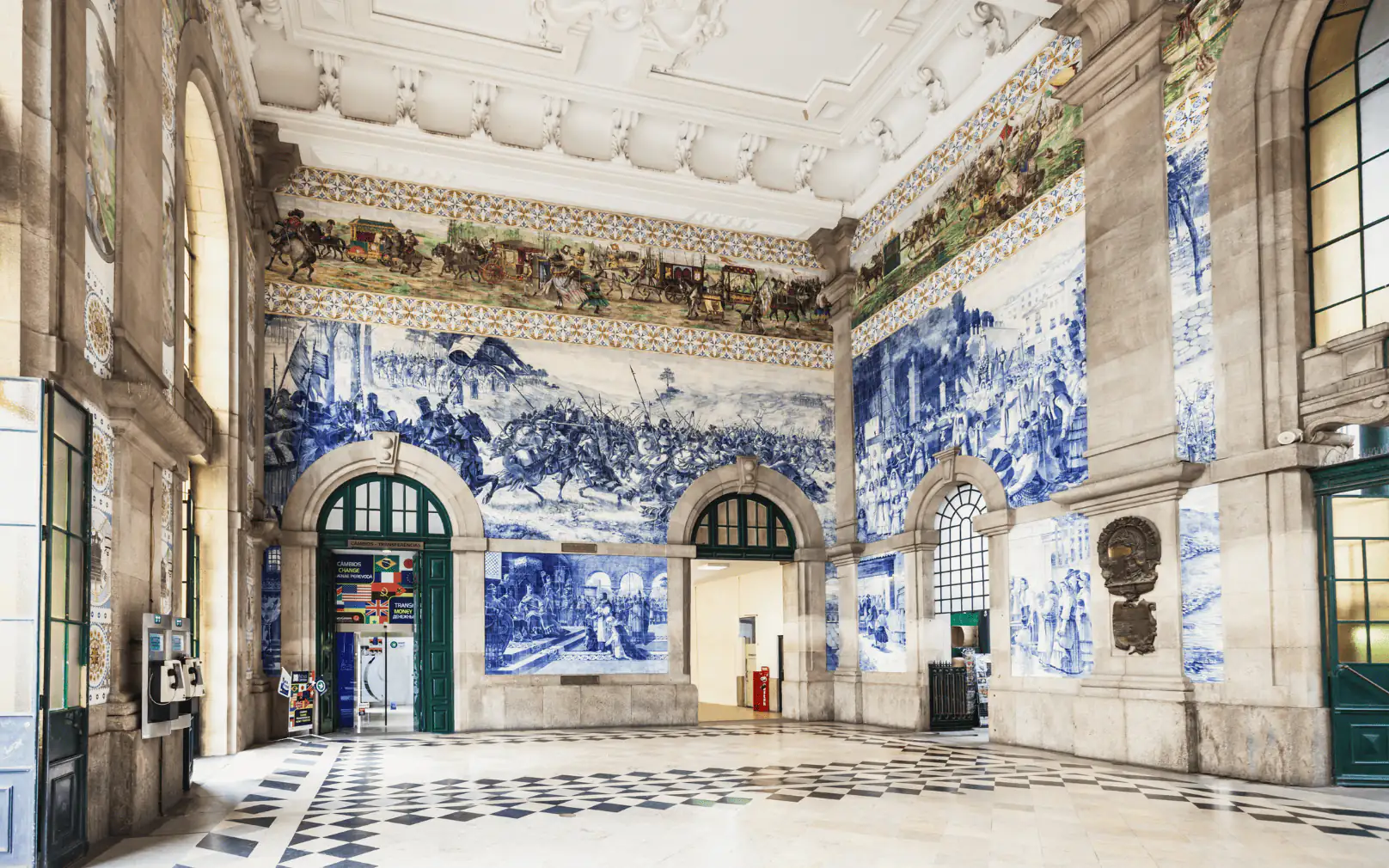The art form known as azulejos holds a significant place in Portuguese culture, history, and art. Azulejos are beautiful ceramic tiles that adorn buildings, churches, and public spaces throughout Portugal. Derived from the Arabic word “al zuleique,” meaning “polished stone,” azulejos are more than just decorative tiles; they represent a rich tapestry of Portuguese heritage and craftsmanship.
Portuguese tiles have played a crucial role in shaping the artistic and historical landscape of the country. For centuries, they have served as a medium for artistic expression, allowing artists to convey stories, commemorate historical events, and showcase cultural traditions. These tiles not only beautify architectural structures but also serve as a testament to Portugal’s vibrant history, reflecting the diverse influences and artistic styles that have shaped the nation over the years. From intricate patterns to elaborate narratives, Portuguese tiles are a testament to the skill and creativity of the artisans who crafted them, and they continue to be treasured and celebrated to this day.
Influences and Origins of Azulejos
The influence of Islamic and Moorish cultures on Portuguese tiles cannot be overstated. When the Moors conquered the Iberian Peninsula in the 8th century, they brought with them a rich tradition of intricate tile work. Islamic art, with its emphasis on geometric patterns and arabesques, had a profound impact on Portuguese tile-making. The Moors introduced advanced techniques such as luster glazes, which added shimmering metallic effects to the tiles. The interlocking geometric patterns, often based on mathematical principles, created mesmerizing designs that adorned palaces, mosques, and public buildings.
Arabic calligraphy also found its way into Portuguese tile design, with verses from the Quran or poetic texts inscribed on the tiles. These inscriptions added a spiritual and intellectual dimension to their visual appeal. The delicate balance between mathematical precision and aesthetic beauty became a hallmark of Islamic-inspired azulejos.
During the Age of Discoveries, Portugal’s maritime expeditions led to increased contact with other European nations, including Spain and the Netherlands, thus introducing new influences and techniques to Portuguese tile-making.
Spanish tiles, particularly those from the region of Seville, were renowned for their blue and white color palette. The Spanish introduced tin-glazed tiles, known as “azulejos de cuerda seca,” which involved applying tin oxide over the glaze to create a white background. This technique allowed for vibrant cobalt blue pigments to stand out, resulting in a striking visual contrast. The popularity of blue and white tiles soared in Portugal, and they became synonymous with azulejo design.
The Dutch, known for their mastery of ceramic arts, also left their mark on Portuguese tiles. Dutch tile painters introduced narrative elements, depicting scenes from mythology, history, and daily life. These storytelling tiles often portrayed intricate details and conveyed a sense of movement and drama. The Dutch influence encouraged Portuguese artists to explore new subjects and experiment with depicting complex narratives within the limited space of the tiles.
The fusion of these diverse influences—Islamic, Moorish, Spanish, and Dutch—gave rise to the unique style of Portuguese azulejos. It became a testament to the cultural exchange and artistic cross-pollination that occurred during Portugal’s golden age of exploration. The intricate patterns, vibrant colors, and storytelling aspects of azulejos reflect the assimilation of ideas and the evolution of the art form throughout history. To this day, Portuguese tiles continue to captivate with their rich heritage and timeless beauty.
A Brief Overview of the Evolution of the Azulejos
13th-14th century: the art of tile-making arrives in Portugal with the influence of Islamic and Moorish ceramic traditions brought by the Moors.
15th century: the use of azulejos becomes more prominent in Portugal, particularly in religious buildings, as a response to the Gothic and Renaissance architectural styles.
16th century: azulejos gain popularity as a decorative element in the interiors and exteriors of churches, monasteries, and palaces. Influences from Italian Renaissance and Spanish Mudejar styles can be seen throughout the designs.
17th century: the Golden Age of azulejos in Portugal, characterized by the expansion of tile production and the emergence of renowned tile workshops. Intricate blue and white patterns dominate the designs, often depicting religious and historical scenes.
18th century: Baroque and Rococo styles influence azulejos, introducing more elaborate ornamentation and color palettes. Tiles with polychrome designs become popular, incorporating shades of blue, yellow, and green.
19th century: Neoclassical and Romantic styles influence azulejos, resulting in tiles with softer colors and delicate floral motifs. The industrial revolution introduces new production techniques, such as lithography, enabling mass production of tiles.
20th century: Art Nouveau and Art Deco movements leave their mark on azulejos, introducing more geometric patterns and stylized designs. Modernist and abstract influences also emerge during this period.
Late 20th century to now: azulejos experience a revival and renewed interest as part of Portugal’s cultural heritage. Contemporary artists and craftsmen continue to create innovative designs, combining traditional techniques with modern aesthetics.
Today, azulejos can be found in various architectural contexts, including churches, palaces, public buildings, and private homes. They continue to be cherished as a symbol of Portuguese artistry and cultural identity, captivating both locals and visitors with their beauty and historical significance.

Characteristics of Portuguese Tiles
Portuguese tiles are crafted with precision and expertise using carefully selected materials and intricate techniques, ensuring their durability and artistic quality. The process begins with high-quality clay, which forms the base of the tiles. This clay is meticulously sourced and processed to achieve the desired consistency and strength. Artisans then apply glazes to the tiles, such as tin glaze and lead glaze. Tin glaze creates a glossy white surface, while lead glaze allows for a vibrant range of colors. After the glazing process, the tiles undergo firing in kilns at high temperatures. This firing process fuses the clay and glazes together, resulting in durable and long-lasting tiles that can withstand the test of time.
Portuguese tiles are renowned for their captivating design motifs and patterns, reflecting the country’s rich cultural heritage and artistic traditions. These designs add depth, beauty, and storytelling elements to the tiles.
One of the prominent design features found in Portuguese tiles is geometric patterns. Inspired by Islamic and Moorish influences, these patterns consist of intricate interlocking shapes, such as stars, polygons, and arabesques. The precise arrangement of these geometric patterns creates visually stunning compositions, with their symmetrical and balanced nature lending a sense of harmony to the overall tile design.
Floral and nature-inspired designs are also prevalent in Portuguese tiles. Artisans skillfully depict intricate flowers, vines, leaves and fruit, drawing inspiration from the country’s lush landscapes and natural beauty. These designs showcase the attention to detail and craftsmanship of the artists, infusing the tiles with a sense of vibrancy and organic elegance.
In addition to geometric and nature-inspired designs, Portuguese tiles often feature narrative and historical scenes. These tile panels tell stories and depict important historical events, mythological tales, and everyday life. With meticulous attention to detail, artists capture these narratives on the tiles, creating visually engaging compositions that invite viewers to immerse themselves in the stories being portrayed.
The combination of these design motifs and patterns results in a rich tapestry of artistic expression. Each tile is carefully handcrafted, with artisans paying close attention to every intricate detail. The resulting tiles are not only decorative elements but also works of art that reflect the cultural, historical, and artistic identity of Portugal.
Historical and Cultural Significance
Azulejos have played a pivotal role in the architectural decoration of Portugal for centuries. They have been widely used to embellish both public and private buildings, churches, palaces, and even humble homes. The integration of azulejos into architectural design has not only added beauty and elegance but also served practical purposes such as insulation and protection against the elements.
The strategic placement of azulejos on building facades, interior walls, and even ceilings has transformed ordinary structures into vibrant works of art. The tiles have become integral parts of Portugal’s urban and rural landscapes, defining the visual identity of cities and towns across the country.
Recognizing the historical and cultural significance of azulejos, efforts have been made to preserve and restore these unique art forms. Organizations, institutions, and dedicated individuals have undertaken initiatives to safeguard Portugal’s rich tile heritage. Preservation efforts involve documenting and cataloging existing azulejos, particularly those that are at risk of deterioration or destruction. Restoration projects aim to revive damaged or faded tiles, returning them to their original glory. Skilled craftsmen employ traditional techniques and materials to ensure authenticity and historical accuracy during the restoration process.
The restoration of azulejos is not limited to individual tiles but also extends to entire tile panels and murals. These efforts often involve meticulous research and collaboration with experts in tile conservation, art history, and architecture.
Additionally, education and awareness programs have been established to promote the appreciation and understanding of azulejos among the public. Exhibitions, museums, and cultural events showcase the history, craftsmanship, and artistic value of these tiles, helping to foster a sense of pride and cultural heritage among the Portuguese population and visitors alike.
Through these preservation and restoration endeavors, the legacy of azulejos is safeguarded for future generations, ensuring that the art form continues to be cherished and celebrated as an integral part of Portugal’s cultural heritage.
Prominent Examples of Azulejos in Portugal
National Palace of Sintra
The National Palace of Sintra, located in the town of Sintra near Lisbon, is a remarkable showcase of azulejos. Dating back to the 14th century, this palace boasts a stunning collection of tiles that adorn its interior and exterior walls, depicting a wide range of motifs, including geometric patterns, floral designs, and narrative scenes. They provide a captivating glimpse into the rich history and artistic heritage of Portugal.
São Roque Church in Lisbon
The São Roque church, situated in the heart of Lisbon, is another notable example of azulejo artistry. Its interiors are adorned with magnificent panels of azulejos, portraying biblical scenes, saints, and religious narratives. The church’s Chapel of St. John the Baptist is particularly renowned for its intricate use of azulejos, showcasing the skill and artistry of Portuguese tile artisans. The tiles in São Roque Church offer a visual narrative of religious stories and provide visitors with a unique and immersive experience.
Porto’s São Bento Train Station
The São Bento train station in Porto is not only a transportation hub but also a remarkable testament to the beauty of azulejos. The station’s entrance hall is adorned with over 20,000 hand-painted tiles, depicting historical and cultural scenes from Portuguese history. These breathtaking azulejos create a stunning visual spectacle, transporting visitors to a bygone era.
These prominent examples of azulejos in Portugal represent the diverse range of applications and artistic expressions found in Portuguese tile art. From palaces to churches and train stations, these architectural marvels demonstrate the enduring appeal and cultural significance of azulejos. They provide a tangible link to the past, allowing visitors to appreciate the craftsmanship and beauty of this unique art form while immersing themselves in Portugal’s rich history and cultural heritage.

Contemporary Applications and Revival
While deeply rooted in tradition, azulejos have found new life in contemporary applications within interior design and public spaces. Designers and architects continue to incorporate azulejos into modern buildings, hotels, restaurants, and private residences, adding a touch of Portuguese heritage and timeless beauty to these spaces.
In interior design, azulejos are often used as accent features, creating focal points or statement walls. They can be found in kitchens, bathrooms, and living spaces, adding a unique and vibrant aesthetic to the overall design. Modern interpretations of azulejos may experiment with new colors, patterns, and sizes, while still respecting the core principles of the traditional art form.
Public spaces also benefit from the revival of azulejos. Parks, plazas, and urban landscapes incorporate tiled murals, benches, and even entire facades decorated with contemporary interpretations of azulejos. These installations provide a link to the past while infusing a sense of cultural identity and artistic expression into the present.
The contemporary azulejos scene in Portugal is vibrant and dynamic, with numerous talented artists pushing the boundaries of this art form and creating stunning works of tile art. Here are five of the best modern azulejos artists in Portugal:
- Maria Ana Vasco Costa is a contemporary ceramic artist known for her innovative approach to azulejos. Her intricate and colorful tilework combines traditional techniques with modern designs. Her creations can be found in public spaces and private collections in Portugal and abroad.
- Júlio Resende was a prolific painter and ceramic artist, widely regarded as one of the greatest modern azulejos artists in Portugal. His tilework adorns public buildings and churches across the country, including the Church of Nossa Senhora da Conceição in Porto.
- Eduardo Nery specialized in geometric designs and abstract patterns. His tilework can be found in public spaces and buildings throughout Portugal, including the Calouste Gulbenkian Foundation in Lisbon. Nery’s work exemplifies a fusion of modern aesthetics with traditional azulejos techniques.
- Paula Rego, renowned as a painter and printmaker, has also created tile murals that grace public spaces in Portugal. Her figurative work translates beautifully onto tiles, and her murals can be admired at locations such as the subway station at Praça de Espanha in Lisbon.
- Jorge Colaço is best known for his tilework at the São Bento train station in Porto. His murals depict scenes from Portuguese history and daily life, making them one of the greatest examples of modern azulejos in Portugal.
These talented artists have made significant contributions to the world of modern azulejos in Portugal. By combining traditional techniques with contemporary designs, they have created beautiful and unique works of art. Their tilework adorns public buildings, churches, and private collections, inspiring new generations of ceramic artists and keeping the art of azulejos alive and flourishing.
The popularity of azulejos extends beyond Portugal’s borders, with tourists often seeking these decorative tiles as souvenirs to take a piece of Portugal’s unique cultural heritage home with them. The enduring appeal of azulejos as both a traditional and contemporary art form continues to captivate people worldwide.
The Museum of Azulejos
The Museum of Azulejos in Lisbon is a renowned institution dedicated to preserving and showcasing the rich history and artistic heritage of azulejos. This museum serves as a captivating window into the world of Portuguese tile-making, offering visitors a comprehensive understanding of the art form’s evolution, techniques, and cultural significance.
The museum provides a historical backdrop, tracing the origins of azulejos and their development throughout the centuries. It explores how the art form emerged in Portugal and evolved through influences from Islamic, Moorish, Spanish, and Dutch traditions. Visitors gain insight into the historical context that shaped the production and usage of azulejos, providing a deeper appreciation for their cultural importance.
The Museum of Azulejos boasts an extensive collection of tiles, showcasing a diverse range of styles, designs, and themes. The exhibits feature ancient examples of azulejos, displaying both individual tiles and large-scale tile panels. Visitors can observe the intricate craftsmanship, vibrant colors, and beautiful patterns that define Portuguese tile art. It highlights the versatility of azulejos, illustrating how they have been utilized in different contexts throughout history.
The Museum of Azulejos also offers educational programs and workshops designed to promote a deeper understanding of the art of tile-making. These initiatives cater to both children and adults, providing interactive experiences that allow visitors to learn about the techniques used in producing azulejos. Participants have the opportunity to create their own tile designs, gaining hands-on experience and fostering a connection to this unique art form.
As an institution dedicated to the preservation of azulejos, the museum plays a crucial role in the restoration and conservation of these precious tiles. It showcases the meticulous process involved in preserving historical tiles, including the delicate cleaning, repair, and reintegration of damaged pieces. Visitors can witness firsthand the commitment to safeguarding Portugal’s cultural heritage and ensuring the longevity of Azulejos for future generations.
The Enduring Legacy of Azulejos
The art and history of azulejos have left an indelible mark on Portuguese culture and heritage. These vibrant and intricate tiles have adorned buildings, churches, and public spaces for centuries, captivating the eyes and hearts of locals and visitors alike. The enduring legacy of Portuguese tile-making is a testament to the skill, creativity, and craftsmanship of the artisans who have dedicated themselves to this art form throughout history.
Azulejos have not only served as decorative elements but have also preserved and conveyed narratives, historical events, and cultural symbolism. They have become a visual language that reflects the rich tapestry of Portugal’s past, telling stories of its architectural marvels, religious traditions, and societal values. Whether you’re an art lover or just looking to explore Portugal’s rich cultural history, the azulejos are a must-see attraction
If you are interested in finding a home adorned with azulejos, contact us today. We would love to assist you in finding the perfect place that showcases the cultural heritage and beauty of azulejos, allowing you to experience the charm of these Portuguese tiles in your very ownliving space.


